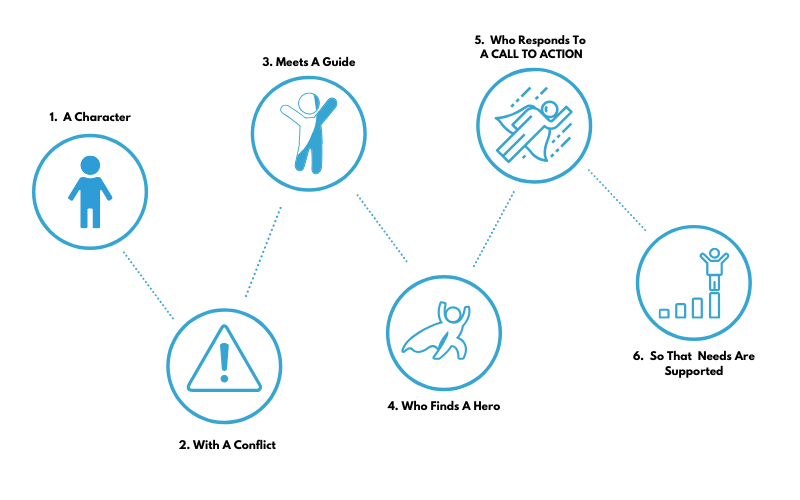

5 min read
It’s the digital age and your organization has almost every tool at your disposal to communicate with people, and most of these tools are FREE! That’s amazing and exciting, but that also means there’s a lot of noise out there, because everyone is doing it.
The question is “How do you cut through the digital noise?”
The good news is that you’re sitting on a gold mine, and the gold is in your story.
Storytelling is a timeless framework that leverages all the good work that you’re doing and puts it into a compelling narrative that inspires people to to help you do the great work that you do!
This blog will touch on the basics and even give you a little more to get your storytelling started. So let’s walk through the Storytelling Framework.

1. Character
This is the community you are serving. To develop the Character, you want to identify a single person who represents the whole. This person’s story is a glimpse into the struggle that people are facing. The details of the character such as their name, age, family, who they are, and their unique struggle are key pieces that will connect with your audience.
“If I look at the mass, I will never act. If I look at the one, I will.” ― Mother Teresa
2. Conflict
This is defined as the unique problem that your Character is facing. The conflict is also connected to the larger problem in your community. For example though you may have a huge problem you are trying to solve, such as homelessness – For the sake of your story and your potential fundraising campaign, you will want to try to focus the story on a goal that you need to meet. Such as “We need $50,000 to upgrade our shelter facility”. With this goal you now have an achievable outcome and a filter in which you can choose the right character and proper story so that you can focus on how that character personifies the need to upgrade your shelter facility.
3. Guide
You and your organization are the guide. This is a very important role and a critical perspective for your organization to understand. You need your whole organization to be focused on guiding your constituents (donors, volunteers, and followers) on a journey to become the Hero of the story. These are the people who ultimately serve the needs of your community and therefore need to be communicated to accordingly. The way that you communicate will help your audience know that they are the most important part to the organization and ultimately the Hero that supports your community. If you confuse yourself, your organization, or your program as the Hero serving your community then you may be completely losing connection with your audience and ultimately losing support and impeding your impact.
4. Hero
Your audience is your Hero – those people who are in your contact list – (Social Media Followers, Email Followers, Volunteers, Donors, and Constituents). Your audience wants to feel like they’re making a difference for the causes they care about. To do this you need these people to feel like they are the solution to the cause – because they are! Without their gifts, voice, and volunteer efforts then there is virtually no solution. Your supporters are the Hero of the story, so be sure not to confuse this with your organization and staff. This can be easy to do. You are in fact the Guide, not the Hero.
5. Call To Action
This is where you present your plan and make your appeal. The clearer you make your plan and appeal, the more impactful you will be. Though the actual internal plan, (facts and figures) may be full of detail and nuance, you must make it very simple and boiled down. As the Guide in the story, your constituents are looking for the answer to the problem and how to respond accordingly as the Hero. If you confuse them with facts, figures, and nuance then you will lose their attention and support! Remember, this is not a grant report. So you must present a simple plan; usually with 3-4 bullets with 1-2 sentences. Then let your audience know what you would like from them and why.
Your “Why” is the most important question that needs to be answered for your audience and it needs to be answered with intention. You then use the conflict of your main character’s story to paint a picture of how life will be better for the community because they responded. Don’t shrink back on the appeal. Be intentional, and direct, and invoke purpose and emotion. Your audience wants to feel like they are making a difference, and that feeling is a powerful retention moment for their heart to connect to your cause for the long term.
Now that you have the framework, consider what kind of stories you need to tell and then run those through the framework. For example, here are three primary stories that you need to be communicating:
1. Fundraising Stories – Stories that help your cause raise money.
2. Impact Stories – Stories that show impact, either successes or challenges.
3. Thank You Stories – Stories that show gratitude for your constituents.
Once you’ve thought through some of the stories you could share, put them into action and reach out to me. I’d love to hear how it’s going!
